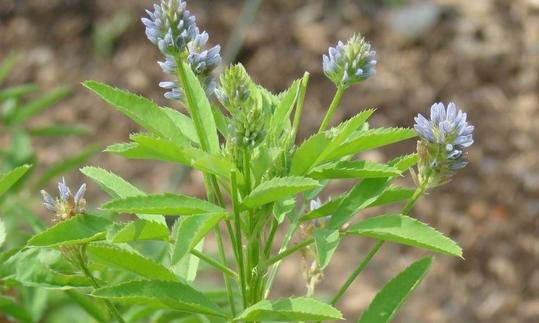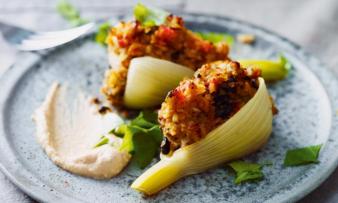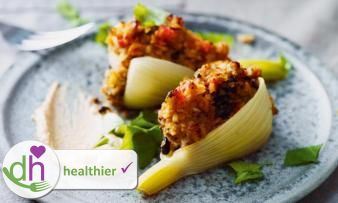Table of contents
The spicy savory clover ( Trigonella caerulea) is known, depending on the region, as bread clover, hay clover, ziger clover or cheese clover, etc.
Use in the kitchen:
Fresh Schabzigerklee (sometimes also written Schabziegerklee) is rarely used. Its special aroma only develops after the leaves have been dried. This clover is best known in dried form as a spice or powder. Its taste is somewhat milder than that of dried fenugreek leaves. Nevertheless, it tastes strongly spicy to bitter and is reminiscent of fresh hay. Some people find the scent similar to lovage. In the Swiss Glarus region, a cheese, the Schabziger, is seasoned with dried, powdered Schabzigerklee leaves. In South Tyrol, the Zigainerkraut is included in Vinschgau flatbread and Schüttelbrot alongside the traditional bread spices fennel, caraway, coriander and anise. The spice can also be found in many Indian vegetable recipes. Blue sweet clover can also be used for onion, potato and mushroom soups. 1
Schabzigerklee is also suitable as a spicy seasoning on rolls, waffles or in salads, dips and spreads. Many people love the spicy-bitter combination with cheese, eggs and potatoes. 2 Although the taste is boil-proof, it is better to add the seasoning shortly before serving when using it for cooked dishes.
In Georgian cuisine, savory is known as Utskho Suneli. This "foreign spice" can be found pure and as a mixture in vegetable casseroles, soups, sauces and traditionally in various ragout-like dishes. In Georgia, the leaves are used less and the seeds with the capsule are used more. Outside Georgia, fenugreek seeds are more commonly used. 3
The flowers are also edible. They can be dried and ground together with the leaves or used as a pretty plate decoration.
Vegan recipe for carrot and pumpkin seed bread:
Ingredients: 500 g whole wheat flour, 200 ml warm water, 20 g fresh baking yeast, 2 carrots (finely grated), 10 g herb salt, 1 tbsp wheat germ oil, 1/2 tbsp bread spice ( anise, fennel, caraway), 1/2 tbsp savory, 4 tbsppumpkin seeds, 5 g salt.
Preparation: Put all the ingredients in a bowl and knead well. Add the pumpkin seeds at the end and knead lightly. Leave the dough to rest in a warm place until it has roughly doubled in volume. Then knead the dough again. Form a loaf and place it in a bread basket or in a greased loaf pan. Leave the dough to "rise" for another 20 minutes, then brush with water and bake for 10 minutes in a preheated oven at around 230 °C. Then finish baking for another 30 minutes at 180 °C (top and bottom heat). The baking time depends largely on the size of the loaf.
| Not only vegans or vegetarians should read this: Vegans often eat unhealthily. Avoidable nutritional errors. |
Shopping - where to buy?
You can find savory as a coarsely chopped spice, in powder form or as savory seeds in health food stores, organic shops, natural food stores or online. If possible, buy the spice in organic quality. Supermarket chains such as Coop, Migros, Denner, Volg, Spar, Aldi, Lidl, Rewe, Edeka, Hofer etc. usually do not offer this spice.
Homemade preparation:
You can easily dry shamrock leaves yourself and process them into powder. To do this, harvest the fresh leaves when they are in bloom and let them dry in a dark, cool and airy place. The optimum degree of dryness is achieved when the leaves audibly crack and crumble between your fingers. Remove the coarse stems and put the rest in a spice mill or old coffee grinder and grind until you have achieved the desired degree of fineness. When dried, the spice is very intense. As an example of quantity: When using in bread, you need around 4-6 g of bread shamrock spice for 1 kg of flour.
Found in the wild:
This clover is believed to have its origins in the cultivated plant Trigonella procumbens, which is native to the eastern Mediterranean and the Caucasus. There, Schabziger clover can occasionally be found growing wild in some meadows and on roadsides.
Storage:
Dried and ground, savory clover should be stored in a cool, dark place in a well-sealed container. If stored properly, it will last for several years. Fresh leaves should be used quickly as they lose their aroma very quickly. Savory clover can also be frozen, which means it will last for several months.
Ingredients - nutritional value - calories:
Clover plants are very rich in protein, but when used as a spice the content is less significant. Schabzigerklee contains essential oils, tannins and bitter substances. Schabzigerklee has its spicy-bitter taste because of the α-keto acids it contains, such as pyruvic acid.
Health aspects - effects:
Due to the bitter substances it contains, fenugreek stimulates the appetite and digestion, and sometimes even has a laxative effect. 2,4 It is also said that fenugreek has blood sugar-lowering and blood-building properties.
Dangers - Intolerances - Side effects:
If you have a food allergy or intolerance to legumes, you should avoid eating savory clover. Allergies often manifest themselves immediately after consumption in the form of severe itching in the mouth and throat. An intolerance is only recognized later when there is a change in the digestive process (e.g. flatulence, cramps, etc.).
Folk medicine - natural medicine:
Blue clover is often used as a medicinal herb in the Middle East and on the Arabian Peninsula. The most effective are the dried seeds and flowering shoots of the blue clover. Chinese traditional medicine (TCM) knows this clover as a strengthening and rejuvenating agent. It is also said to have an aphrodisiac effect. 4
Occurrence - Origin:
Schabziger Klee originally comes from the eastern Mediterranean region and Asia Minor. Schabziger Klee probably reached Europe in the 9th century. There it was initially only found in monastery gardens. Even today it is still popular mainly in the Alps and the Caucasus.
Cultivation - harvest - season:
The seeds of the gypsy clover are sown privately in the garden in spring (not "sown"). When grown commercially, the seeds are usually sown in August. The gypsy clover loves sunny locations and well-drained soil. Today it is only cultivated in a few areas. If it is, then it is usually organically grown, such as in South Tyrol and Switzerland. There, the gypsy clover grows up to 1200 m above sea level in good growing conditions. The first harvest of the herb takes place in autumn. If left over the winter, the green cover has a protective effect and is kind to the soil. The second, most productive harvest takes place in April, at this time the clover has the best aroma. So you can't really say there is a season. Ideally, the herb is harvested up to 4 times a year.
After cutting, the greens should be dried immediately and the coarse parts of the plant should be sorted out, chopped and packed. From June/July, the clover is left to bloom in its light violet to light blue color. After the seeds have ripened, the savory clover is cut and threshed for your own seed use or the seeds can be used as a spice. The seeds are directly in the flower calyx and no pods form like with fenugreek. When growing fenugreek organically, weed control is usually done by hand and is therefore very labor-intensive. 5
The taproots of the blue clover live in symbiosis with bacteria that can convert atmospheric nitrogen into nitrogen that is available to plants. These nodule bacteria are known to occur in many legumes. The nitrogen collected is not only available to the blue clover itself, but also to subsequent crops. 2
Cultivation as a potted plant:
The blue clover can be cultivated in a pot on the balcony or terrace, but it is not suitable as a houseplant. It needs humus-rich soil and a sunny to partially shaded location. It does not tolerate waterlogging or long dry periods. In a pot, you should reseed 2-3 times a year so that new, fresh leaves keep forming. If the leaves of the annual plant have a brownish color in autumn, they are no longer suitable for use as a spice.
Danger of confusion:
Schabzigerklee is very closely related to fenugreek and the leaves can easily be confused with each other, fresh or dried. The flower shape and color are very different, however. The spicy-bitter taste is also used in a similar way. Both could be used as a substitute for each other, although fenugreek should be used more sparingly due to its intensity.
Animal protection - species protection - animal welfare:
Sweet clover is very popular with bees because the numerous flowers have a very strong scent. 2 This makes sweet clover a very good bee pasture.
General information:
The blue clover ( Trigonella caerulea) comes from the genus Trigonella within the legume family (Fabaceae, Leguminosae). According to Wikipedia, other botanical synonyms are known: Melilotus coerulea (L.) Desr., Melilotus coeruleus (L.) Desr., Trifolium caerulea L., Trigonella coerulea (Desr.) Ser., Trigonella melilotus-coerulea (L.) Asch. & Graebn., Trigonella melilotus-coeruleus (L.) Asch. & Graebn. 2 The triangular flower shape ("trigonus") gave the plant its botanical name Trigonella.
Since 1825, the common sainfoin has been classified in the genus Trigonella 6, while the meadow clover and its relatives belong to the genus Trifolium. Both genera belong to the subfamily Faboideae and the legume family Fabaceae.
Other alternative names are gypsy clover, hay clover, zigerklee, zigerkraut, zigerchrut, blue sweet clover, blue honey clover, muskrat and witch's herb. 3,4 But zigainerkraut and blue fenugreek also occur. In English, schabzigerklee is known as blue fenugreek.
The name Schabzigerklee (or Schabziegerklee) comes from its use in cheese production. In Switzerland, "Ziger" refers to the milk proteins separated from the whey, in Austria the word "Topfen" is used and in Germany "Quark" is used. In Switzerland, there has been a Zigerkraut producers' association (Lachen/SZ) since 1917, which has the sole right to purchase the clover powder needed to make Schabziger cheese.
Literature - Sources:
Bibliography - 6 Sources
| 1. | Brotklee.it Südtiroler Brotklee. |
| 2. | Wikipedia Schabzigerklee. |
| 3. | Gernot-katzers-spice-pages.com Schabziegerklee (Trigonella caerulea). |
| 4. | Vituro.ch Kräuterwissen Schabziger-Klee. |
| 5. | Geska.ch Über Ziegerklee. |
| 6. | Global Biodiversity Information Facility (GBIF) Trigonella caerulea. |







Comments